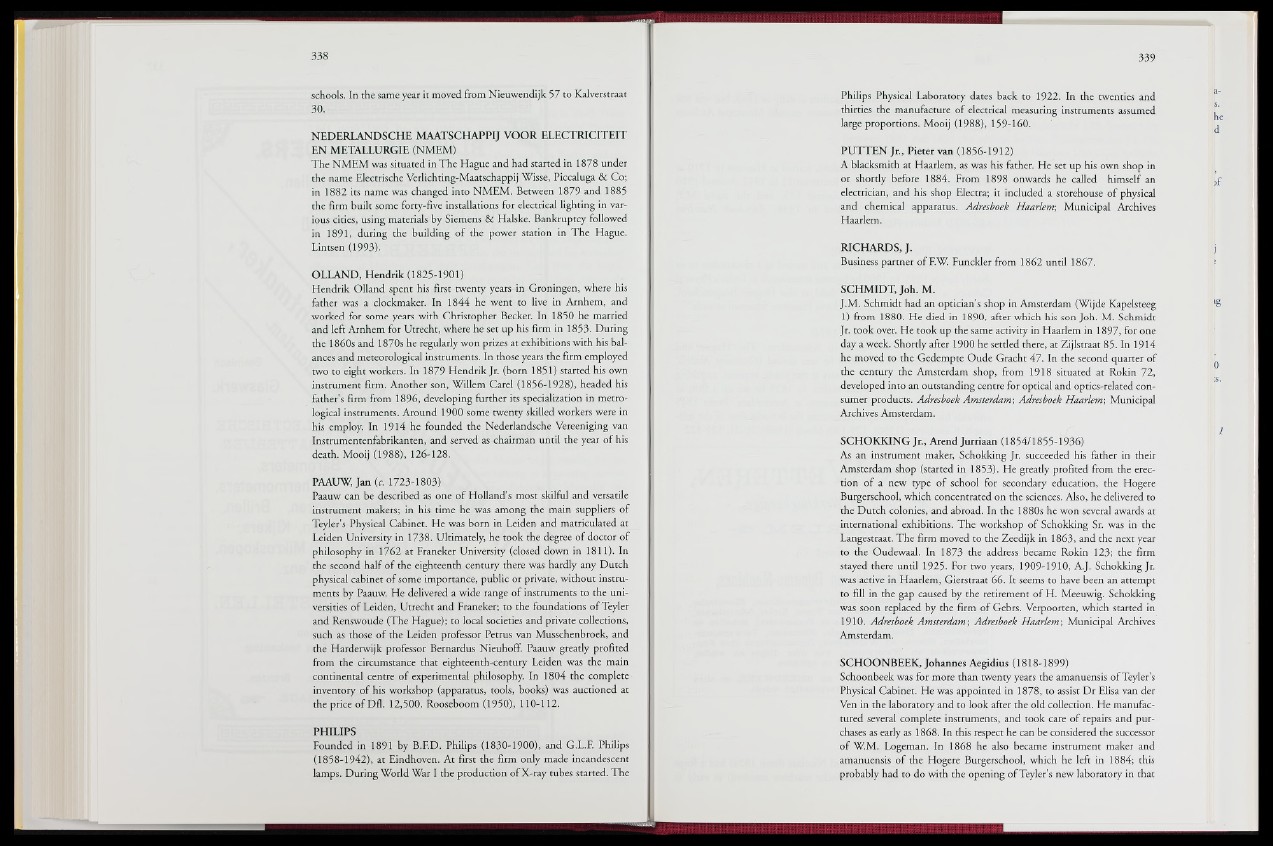
schools. In the same year it moved from Nieuwendijk 57 to Kalverstraat
30.
NEDERLANDSCHE MAATSCHAPPIJ VOOR ELECTRICITEIT
EN METALLURGIE (NMEM)
The NMEM was situated in The Hague and had started in 1878 under
the name Electrische Verlichting-Maatschappij Wisse, Piccaluga & Co;
in 1882 its name was changed into NMEM. Between 1879 and 1885
the firm built some forty-five installations for electrical lighting in various
cities, using materials by Siemens & Halske. Bankruptcy followed
in 1891, during the building of the power station in The Hague.
Lintsen (1993).
OLLAND, Hendrik (1825-1901)
Hendrik Olland spent his first twenty years in Groningen, where his
father was a clockmaker. In 1844 he went to live in Arnhem, and
worked for some years with Christopher Becker. In 1850 he married
and left Arnhem for Utrecht, where he set up his firm in 1853. During
the 1860s and 1870s he regularly won prizes at exhibitions with his balances
and meteorological instruments. In those years the firm employed
two to eight workers. In 1879 Hendrik Jr. (born 1851) started his own
instrument firm. Another son, Willem Carel,(1856-1928), headed his
father's firm from 1896, developing further its specialization in metrological
instruments. Around 1900 some twenty skilled workers were in
his employ. In 1914 he founded the Nederlandsche Vereeniging van
Instrumentenfabrikanten, and served as chairman until the year of his
death. Mooij (1988), 126-128.
PAAUW, Jan (c. 1723-1803)
Paauw can be described as one of Holland's most skilful and versatile
instrument makers; in his time he was among the main suppliers of
Teyler's Physical Cabinet. He was born in Leiden and matriculated at
Leiden University in 1738. Ultimately, he took the degree of doctor of
philosophy in 1762 at Franeker University (closed down in 1811). In
the second half of the eighteenth century there was hardly any Dutch
physical cabinet of some importance, public or private, without instruments
by Paauw. He delivered a wide range of instruments to the universities
of Leiden, Utrecht and Franeker; to the foundations ofTeyler
and Renswoude (The Hague); to local societies and private collections,
such as those of the Leiden professor Petrus van Musschenbroek, and
the Harderwijk professor Bernardus Nieuhoff. Paauw gready profited
from the circumstance that eighteenth-century Leiden was the main
continental centre of experimental philosophy. In 1804 the complete
inventory of his workshop (apparatus, tools, books) was auctioned at
the price of Dfl. 12,500. Rooseboom (1950), 110-112.
PHILIPS
Founded in 1891 by B.F.D. Philips (1830-1900), and G.L.F. Philips
(1858-1942), at Eindhoven. At first the firm only made incandescent
lamps. During World War I the production of X-ray tubes started. The
Philips Physical Laboratory dates back to 1922. In the twenties and
thirties the manufacture of electrical measuring instruments assumed
large proportions. Mooij (1988), 159-160. j
PUTTEN Jr., Pieter van (1856-1912)
A blacksmith at Haarlem, as was his father. He set up his own shop in
or shordy before 1884. From 1898 onwards he called himself an }f
electrician, and his shop Electra; it included a storehouse of physical
and chemical apparatus. Adresboek Haarlem; Municipal Archives
Haarlem.
RICHARDS, J. j
Business partner of F.W. Funckler from 1862 until 1867. :
SCHMIDT, Joh. M.
J.M. Schmidt had an optician's shop in Amsterdam (Wijde Kapelsteeg '8
1) from 1880. He died in 1890, after which his son Joh. M. Schmidt
Jr. took over. He took up the same activity in Haarlem in 1897, for one
day a week. Shortly after 1900 he settled there, at Zijlstraat 85. In 1914
he moved to the Gedempte Oude Gracht 47. In the second quarter of
the century the Amsterdam shop, from 1918 situated at Rokin 72,
developed into an outstanding centre for optical and optics-related consumer
0
' is.
products. Adresboek Amsterdam; Adresboek Haarlem; Municipal
Archives Amsterdam.
SCHOKK3NG Jr., Arend Jurriaan (1854/1855-1936)
As an instrument maker, Schokking Jr. succeeded his father in their
Amsterdam shop (started in 1853). He gready profited from the erection
of a new type of school for secondary education, the Hogere
Burgerschool, which concentrated on the sciences. Also, he delivered to
the Dutch colonies, and abroad. In the 1880s he won several awards at
international exhibitions. The workshop of Schokking Sr. was in the
Langestraat. The firm moved to the Zeedijk in 1863, and the next year
to the Oudewaal. In 1873 the address became Rokin 123; the firm
stayed there until 1925. For two years, 1909-1910, A.J. Schokking Jr.
was active in Haarlem, Gierstraat 66. It seems to have been an attempt
to fill in the gap caused by the retirement of H. Meeuwig. Schokking
was soon replaced by the firm of Gebrs. Verpoorten, which started in
1910. Adresboek Amsterdam-, Adresboek Haarlem-, Municipal Archives
Amsterdam.
SCHOONBEEK, Johannes Aegidius (1818-1899)
Schoonbeek was for more than twenty years the amanuensis of Teyler's
Physical Cabinet. He was appointed in 1878, to assist Dr Elisa van der
Ven in the laboratory and to look after the old collection. He manufactured
several complete instruments, and took care of repairs and purchases
as early as 1868. In this respect he can be considered the successor
of W.M. Logeman. In 1868 he also became instrument maker and
amanuensis of the Hogere Burgerschool, which he left in 1884; this
probably had to do with the opening of Teyler's new laboratory in that